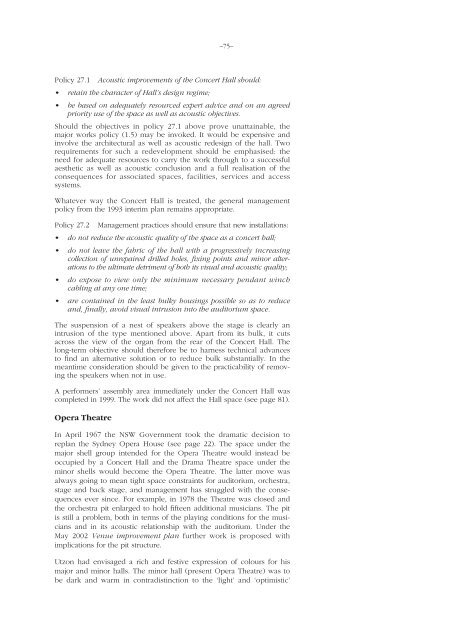Sydney Opera House conservation plan
Sydney Opera House conservation plan
Sydney Opera House conservation plan
Create successful ePaper yourself
Turn your PDF publications into a flip-book with our unique Google optimized e-Paper software.
–75–Policy 27.1 Acoustic improvements of the Concert Hall should:• retain the character of Hall’s design regime;• be based on adequately resourced expert advice and on an agreedpriority use of the space as well as acoustic objectives.Should the objectives in policy 27.1 above prove unattainable, themajor works policy (1.5) may be invoked. It would be expensive andinvolve the architectural as well as acoustic redesign of the hall. Tworequirements for such a redevelopment should be emphasised: theneed for adequate resources to carry the work through to a successfulaesthetic as well as acoustic conclusion and a full realisation of theconsequences for associated spaces, facilities, services and accesssystems.Whatever way the Concert Hall is treated, the general managementpolicy from the 1993 interim <strong>plan</strong> remains appropriate.Policy 27.2 Management practices should ensure that new installations:• do not reduce the acoustic quality of the space as a concert hall;• do not leave the fabric of the hall with a progressively increasingcollection of unrepaired drilled holes, fixing points and minor alterationsto the ultimate detriment of both its visual and acoustic quality;• do expose to view only the minimum necessary pendant winchcabling at any one time;• are contained in the least bulky housings possible so as to reduceand, finally, avoid visual intrusion into the auditorium space.The suspension of a nest of speakers above the stage is clearly anintrusion of the type mentioned above. Apart from its bulk, it cutsacross the view of the organ from the rear of the Concert Hall. Thelong-term objective should therefore be to harness technical advancesto find an alternative solution or to reduce bulk substantially. In themeantime consideration should be given to the practicability of removingthe speakers when not in use.A performers’ assembly area immediately under the Concert Hall wascompleted in 1999. The work did not affect the Hall space (see page 81).<strong>Opera</strong> TheatreIn April 1967 the NSW Government took the dramatic decision tore<strong>plan</strong> the <strong>Sydney</strong> <strong>Opera</strong> <strong>House</strong> (see page 22). The space under themajor shell group intended for the <strong>Opera</strong> Theatre would instead beoccupied by a Concert Hall and the Drama Theatre space under theminor shells would become the <strong>Opera</strong> Theatre. The latter move wasalways going to mean tight space constraints for auditorium, orchestra,stage and back stage, and management has struggled with the consequencesever since. For example, in 1978 the Theatre was closed andthe orchestra pit enlarged to hold fifteen additional musicians. The pitis still a problem, both in terms of the playing conditions for the musiciansand in its acoustic relationship with the auditorium. Under theMay 2002 Venue improvement <strong>plan</strong> further work is proposed withimplications for the pit structure.Utzon had envisaged a rich and festive expression of colours for hismajor and minor halls. The minor hall (present <strong>Opera</strong> Theatre) was tobe dark and warm in contradistinction to the ‘light’ and ‘optimistic’
















